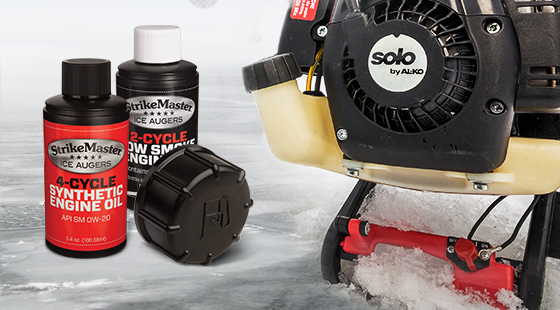
When replacing your auger’s fuel this winter, resist the temptation to add extra oil to the mix, like dad did back in the day.
“Modern motors, like all those in the StrikeMaster line-up, are precision machines, not the oil-guzzling monsters our dads and grandpas lugged onto the ice in the old days,” says ICE FORCE Pro Brad Hawthorne. “So bumping up the oil-to-gas ratio in your auger fuel tank offers no benefit.”
In fact, extra oil can harm your carburetor, make your auger harder to start, and is more likely to leak out your muffler. “You don’t want any of those hassles, so stick with a 40:1 ratio,” Hawthorne says.
That’s 3.2 oz. of oil per 1 gallon of gas. Your best bet is to buy oil in pre-measured 3.2 oz. bottles and add one bottle per 1 gallon of gas in your tank. Note: You can use a 40:1 gas-to-oil mixture even if your engine calls for 24:1. You’ll use less oil and your auger will run better and cleaner.
Fresh, winter-grade gasoline will help your auger run better and cleaner as well. “Don’t run old gas,” Hawthorne says. If you didn’t use up all your gas last winter, transfer it to your lawnmower or weed whipper and fill your auger with fresh gas. “Look at this way – if that old gas is bad, would you rather your weed wacker not start 10 feet from your garage, or your auger not start 100 yards from your ice house?”
In most areas in the Ice Belt, winter-grade gasoline is available November 1 through April 1. Premium fuel will ensure peak performance for your auger.
Don’t run old gas. Your engine will start and run better on fresh, premium, winter-grade fuel, which is usually available most places Nov. 1 through April 1.
Following are a few more pre-season maintenance tips to prep your ice auger like a pro this pre-season. Most can be completed in a matter of minutes with the most basic tools.
Spark
Auger back-firing? Running rough? It’s probably time for a new spark plug.
To check, remove your plug and inspect it for build-up on or around the electrode, cracks in the insulator housing or other obvious signs of wear and tear.
Blades
Was your auger was cutting slower before ice-out last season than it was after ice-up? You’ll want to install new blades this year. Pro tip: Order two sets of replacements blades in one order, so you’ll always have a spare set on hand if something happens to damage your blade during a hot bite.
Starter Rope
Almost every recoil problem is caused by operator error – pulling your starter rope all the way to the end. Potential damage includes a frayed rope or failed spring. To avoid such damage, simply make shorter pulls on your rope.
Before ice-up, check your starter rope. If it’s frayed or retracting slowly or incompletely, don’t wait until it fails on a day the fish are biting – replace it now.
Air Filter
Is your air filter soaked with oil or stained with dirt and grime? It’s time for a replacement. All air filters eventually get dirty and clog, blocking airflow to your engine. The result is an auger that either bogs down when drilling or loses power altogether.
Nuts & Bolts
Before hitting the ice this winter, inspect every exposed nut, bolt and screw head on your auger to ensure that the entire assembly – from powerhead to cutting blades – is torqued properly.
“Why lose fishing time to fasten a loose fastener in freezing temps?” Hawthorne says. “I’d rather check out all my nuts and bolts now, when the weather’s still nice, than out on the ice when it’s cold and I’m on a hot bite.”
Professional Service
Got an issue bigger than routine maintenance? Visit www.strikemaster.com for a list of StrikeMaster Certified Repair Centers near you.
See StrikeMaster Power Ice Auger Accessories